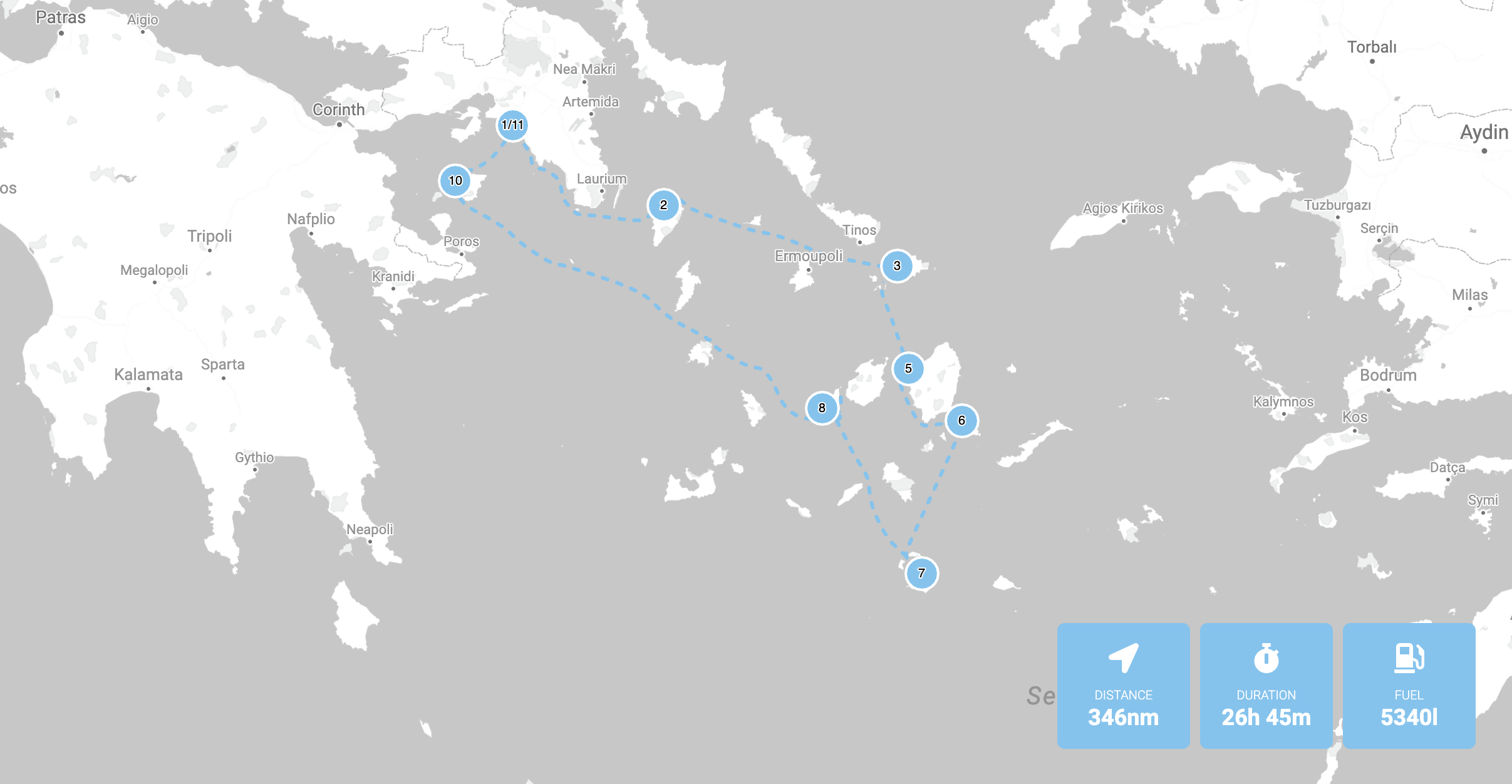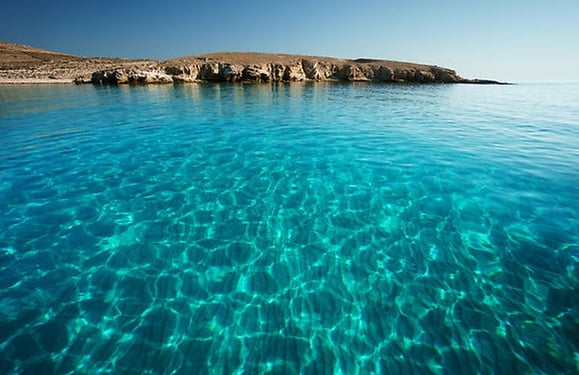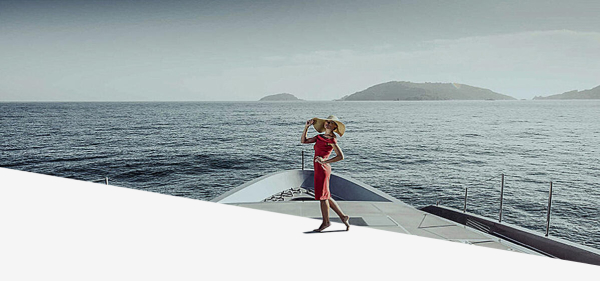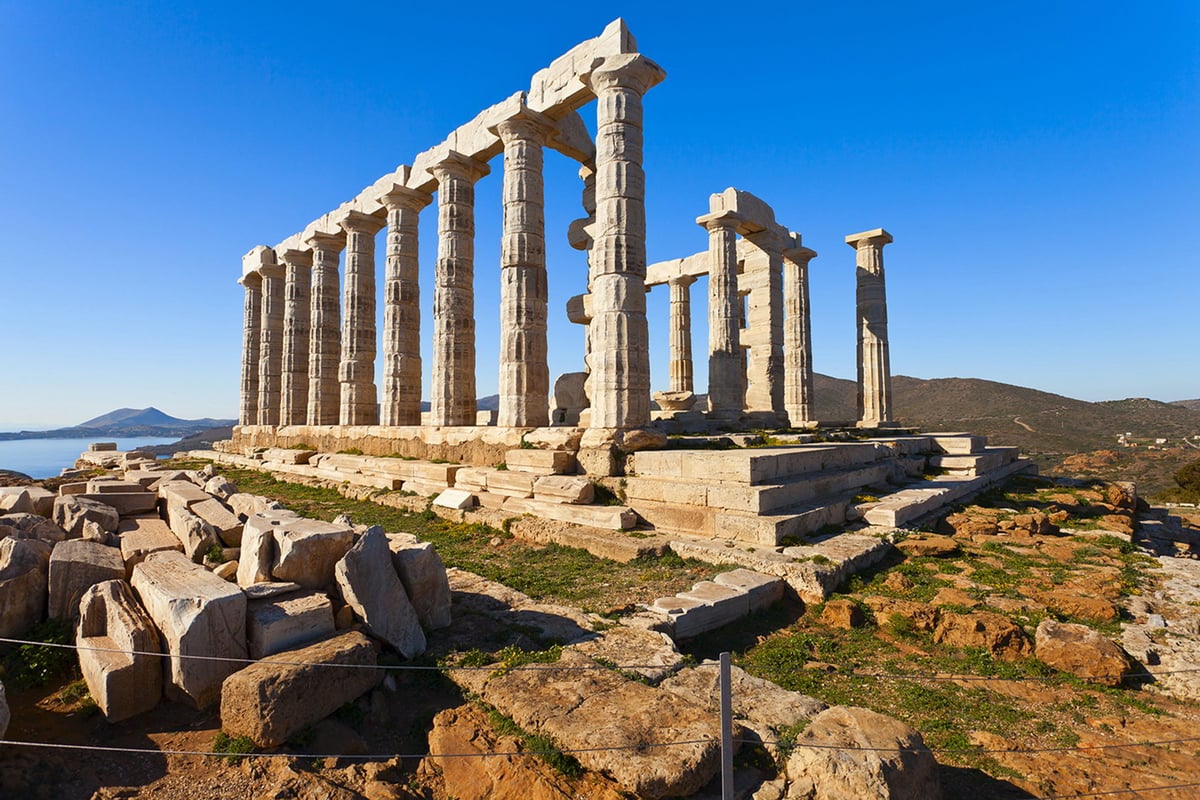
Perhaps archeology isn’t the first thing that comes to mind when considering a yacht holiday, be it on your own yacht or when chartering one. Yachting in Greece, however, presents the perfect opportunity to visit some exceptional archeological locations, and to experience some of the oldest wonders in the world. Greek mythology and ancient history become intertwined in such places, bestowing them a distinct type of enchantment.
SAIL INTO THE PAST
In our latest edition of the Yachtsman Report you will find some of the most important Greek archeological sites that are easily approachable and accessible while journeying on a yacht. They are a wonderful digression from your typical holiday agenda, so do let your captain know that you wish to travel to the past, and he will point you in the right direction.
Sample itinerary - duration and consumption based on a hypothetical journey onboard m/y Milos at Sea.
Click for a detailed itinerary of our "Treasures of Sea and Land" proposal
Tzia (Kea) || Ancient Karthaia
Close to Athens, on the island of Tzia (whose old name, “Kea”, derives from Keos, leader of the Locrian settlers occupying the island in ancient times), you will find the Ancient Karthaia site. Karthaia, one of the four ancient cities of Kea, was founded in the 8th century BC and survived until the early Byzantine period. It was celebrated for its grand architecture, its fortifications, as well as its silver coins, indicating a flourishing, bustling city. Its acropolis was surrounded by walls from both archaic and classical times, with at least six entrances and an extensive defense mechanism including several towers. It contained public buildings and temples, laboratories, mines, water supply systems, a theatre and a cemetery, and there is ample archeological evidence of cultural and artistic activity. The city also boasted autonomy, including its own laws.
Some of the most interesting surviving monuments in Karthaia include the Doric temple of goddess Athena (late 6th century BC), the archaic Temple of Pythion Apollo (530 BC) and the theatre on the south slope of the hill (1st century BC).
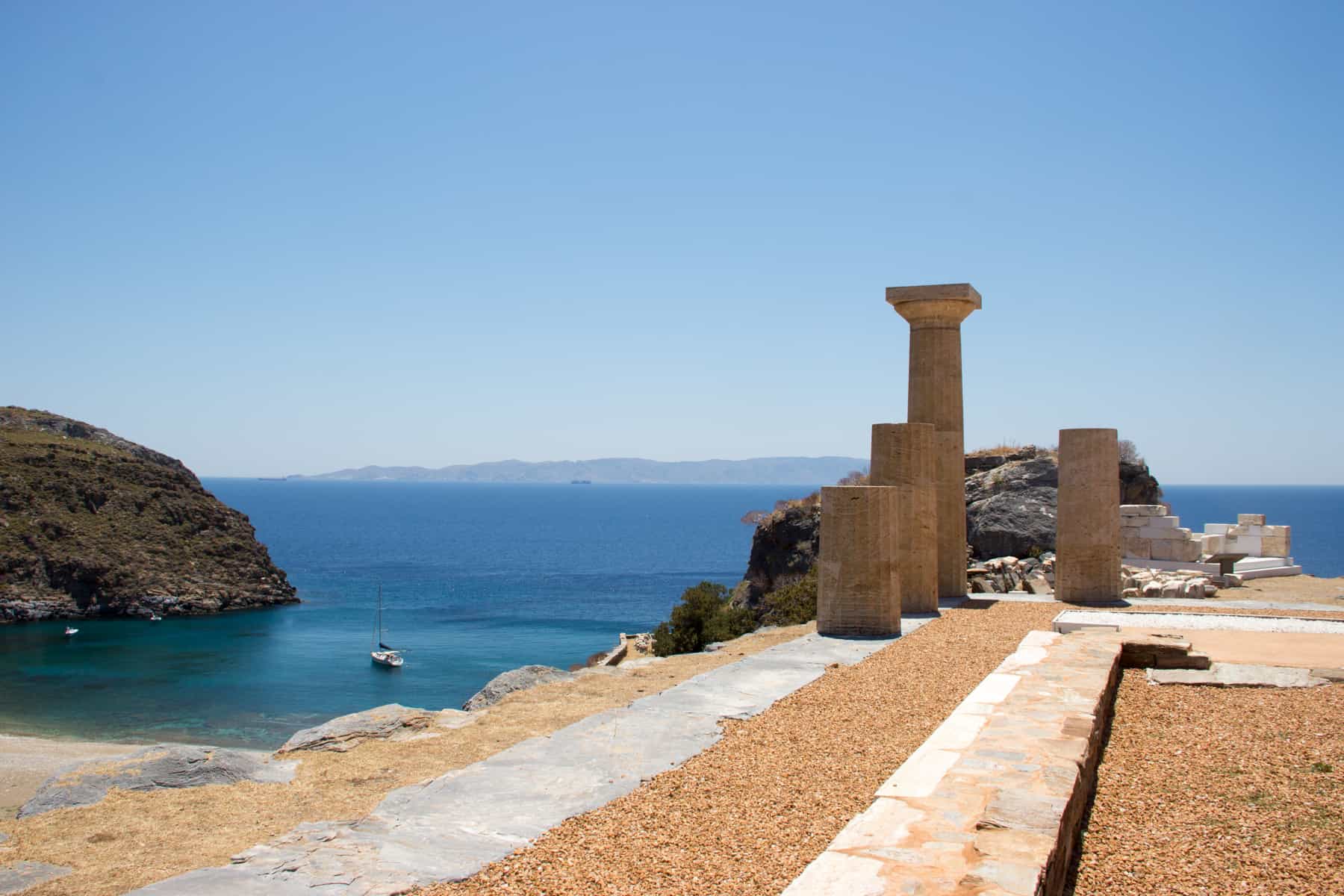 The Doric Temple of Goddess Athena in Ancient Karthea - Source: link
The Doric Temple of Goddess Athena in Ancient Karthea - Source: link
Things to know:
-
You can reach the site by vessel or, if you feel like walking a few hours, do a lovely, long trek from Ioulida (13 km), the capital of Kea, and arrange to be picked up on the beach. There are alternate paths, such as the walk from Stavroudaki, which takes about one hour. If you do decide to walk, make sure you have hats, water and fruit. The beach is unspoiled and magnificent, so you can jump in the sea as soon as you reach Karthaia.
-
Archaeological work there is relatively recent, and some restoration has been done on the foundations of the temples and an ancient theatre (1st century).
-
In 2017, the site won the European Union Prize for Cultural Heritage / Europa Nostra Awards for Conservation.
Mykonos || Delos and Rineia
The island of Mykonos, legendary for its stunning waters and vibrant nightlife, is one of the premier yachting destinations on the planet. It also holds a significant place in Greek mythology, having served as a battleground for Zeus’ clash with the Titans; it was also said to be named after Apollo’s grandson. 1.5 nautical miles from Mykonos is one of the gems of Greek ancient history, the island of Delos; next to it, Rineia (“Big Delos”) complements the story of this extraordinary archaeological location.
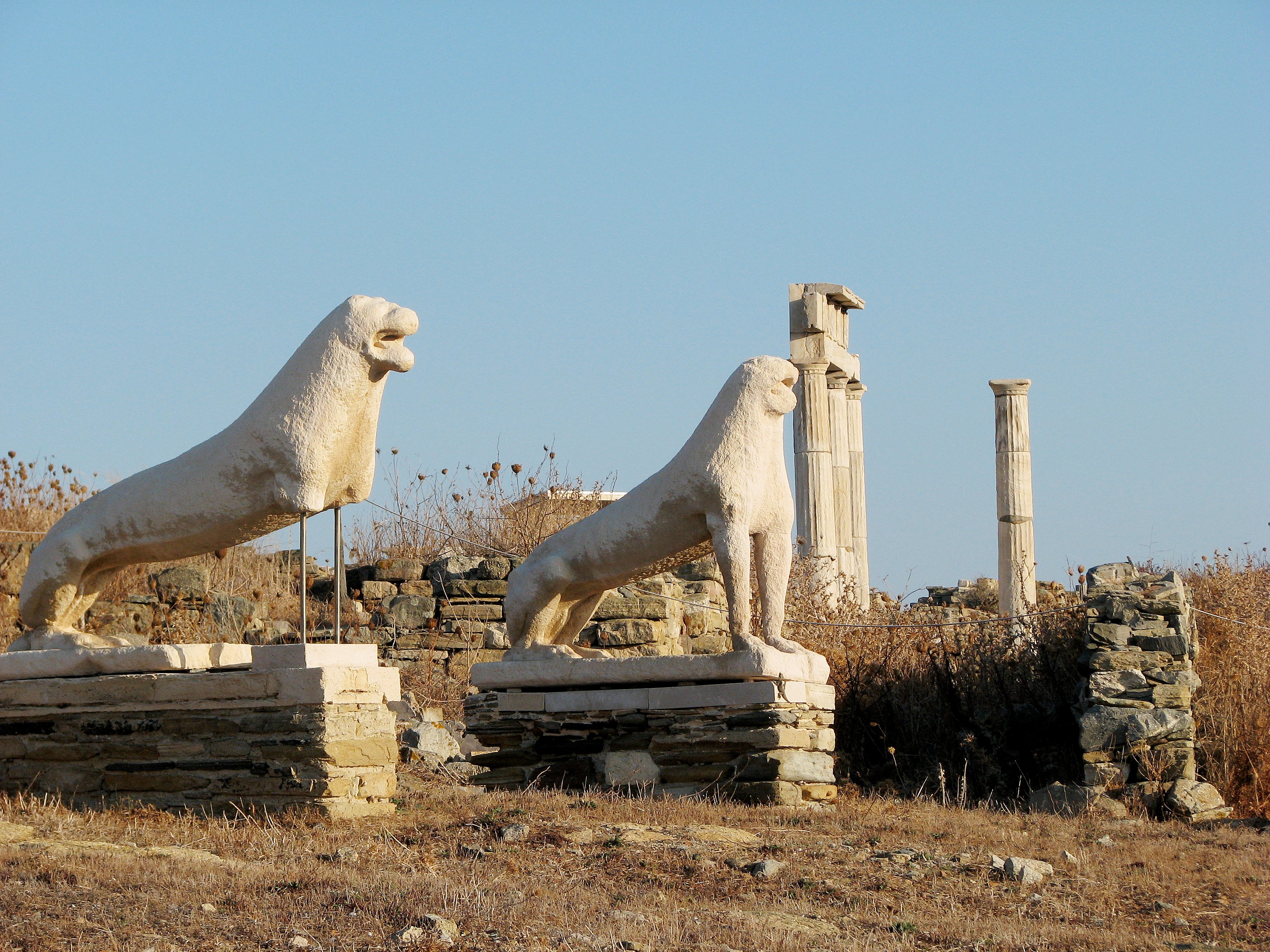
The Terrace of the Lions, island of Delos - Source: link
Delos, a UNESCO World Heritage Site, was first excavated in 1872. It was discovered early on that it was a sacred place for ancient Greeks, and the dense group of islands at the centre of the Aegean Sea, the Cyclades (Kyklades) appeared to form a notional circle (kyklos) around it. In Greek mythology and ancient history (as these are always interwoven in some manner) the island is where the twin gods Apollo and Artemis were born, and the Apollo temple built there attracted pilgrims from many places. It also served as a thriving, cosmopolitan trading port and as the treasury of the Delian League (the Athenian Alliance) in the 5th century BC. What endures today is part of the Apollo sanctuary and remains of the city that developed around it. The most notable things to see are: the Sacred Way, the Terrace of the Lions, the House of Cleopatra (not the Egyptian queen), the House of Dionysus (with its marvelous floor mosaics), the Sacred Precinct and the Heraion (Temple of Hera).
Next to Delos, Rineia, although larger, always played second fiddle to its neighbor. Also dedicated to the Delian Apollo, its southern half served as the Delos necropolis and a ground for clinics and sanatoriums, as it was unlawful for any living being to be born or die on Delos. It was inhabited during the 5th century BC and there are ruins of an ancient temple and a 2,000-year-old Christian church. It’s currently used by Mykonos residents for the purpose of grazing animals.
Things to know:
-
Once you reach the island via yacht or tender, you simply pay a ticket to visit the site and museum, which houses many of the impressive artefacts and statues found on the island. Many of the Delos findings can also be seen in the National Archaeological Museum and the Museum of Cycladic Art in Athens.
-
It’s possible to organize a guided excursion beforehand and find out more about the story of the two islands.
-
It is also possible to hike to the summit of Mt. Kynthos (113 meters), which offers panoramic views over the ruins and countryside, as well as other Cycladic islands: Mykonos, Tinos, Naxos and Syros. Be aware it can be quite windy at the top.
-
In May 2022 Delos hosted an extraordinary event on its sacred ground: a classical concert by the European Youth Orchestra, aimed towards raising awareness about climate change.
Close-up view of Rhenia
Naxos || Portara
Naxos, the biggest of the Cyclades island complex, occupies an illustrious place in Greek mythology. Amongst the many stories connected to it, it’s credited as the place where Zeus, God of Gods, grew up, and where Dionysus, one of Zeus’ most famous children, was brought up by nymphs. The island’s fertile soil and grape cultivation were said to be a direct result of Dionysus’ love for the place.
When approaching the Naxos harbor, you will be greeted by the unique, colossal monument of Portara on the islet of Palatia (or “Bacchus island”), connected to Naxos by land. Its name originates from the Greek word “porta” (“door”) and it’s a marble gateway of monumental proportions: 6m high and 3.5m wide, it consists of separate monoliths weighing about 20 tons each.
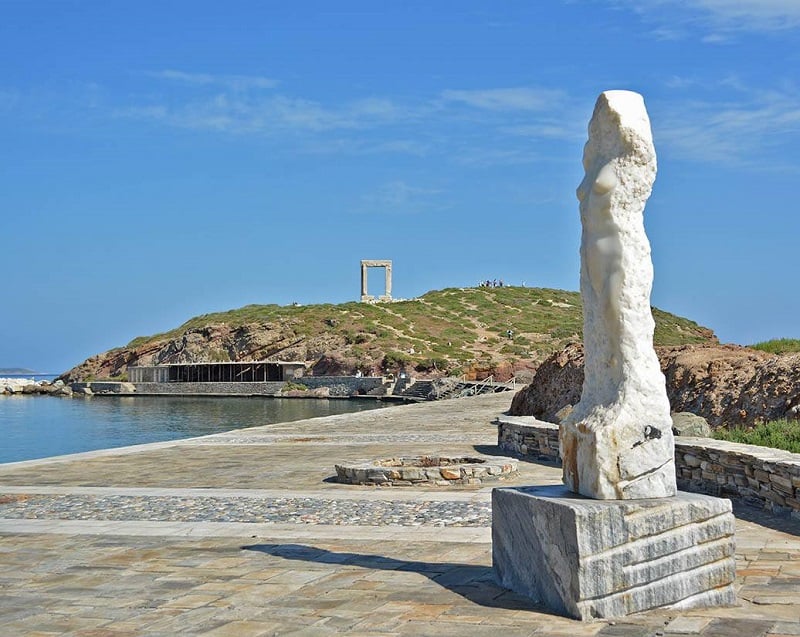
The Ariadne statue and The Portara, the lintel of Lygdamis' Temple of Apollo at Naxos, in the distance - Source: link
Portara was built during the 6th century BC by Lygdamis, the island’s ruler, who ordered the construction of a massive temple of the Ionic architecture style. When war broke out between Naxos and Samos, the work stopped and was never completed. Additionally, in Greek mythology, the islet of Palatia was where Ariadne, the Minoan princess, was abandoned by her lover Theseus after he killed the Minotaur.
Things to know:
-
It is believed that the temple was going to be built in honor of Apollo, yet there are findings that point towards alternative theories, i.e. that its purpose was to exalt Athena or Dionysus.
-
During the Middle Ages, a Christian church was constructed behind the Portara, while during the Venetian rule on the island, the gate was pulled to pieces so that the marble could be used to build a fortress named Kastro (Greek for “castle”). Fortunately, it was too heavy to be completely dismantled.
-
It’s better to climb the steep hill of the Portara half an hour before sunset, as the spectacle of the sun going into the sea through the gate is one-of-a-kind.
Koufonissi || Keros
Keros is 2 nautical miles south of Koufonissi and in ancient times it was called Keria, the first mention of its name occurring in 425 BC. A small island full of beautiful marble, it was the site of a major Bronze Age settlement on the neighboring islet of Daskalio, built, pyramid-like, on terraces at the island’s highest point. The settlement, abandoned around 2200 BC, boasted impressive buildings (constructed with Naxian stone), metallurgical workshops and complex systems of water transport, as well as other signs of an advanced civilization. During the Middle Ages Keros was used as a pirate stronghold and until 1952 it was the property of the monastery of Panagia Chozoviotissa of Amorgos.
Keros’ most famous archaeological finds, dating from the era of the Cycladic civilization, are its marble Cycladic figurines, connected to various ancient rituals. These include the famous harpist and flutist exhibited at the National Archaeological Museum in Athens.
Things to know:
- You may visit Keros with you yacht but staying overnight is prohibited by the Archaeological Authority, and only archaeologists with legal permits are allowed to visit it on foot.
-
Keros has been looted repeatedly by illegal antiquarian diggers, in one of the saddest such cases of archeological theft. From there comes the so-called "Keros Hoard”, previously in the Erlenmeyer collection and today, the largest part of it (81 pieces out of the 350 deliberately broken marble figurines), in the Museum of Cycladic Art in Athens. Finds from Keros are also exhibited in the Museum of Naxos.
-
Artists such as Modigliani, Picasso and Brancusi called the marble figurines “magical objects.”
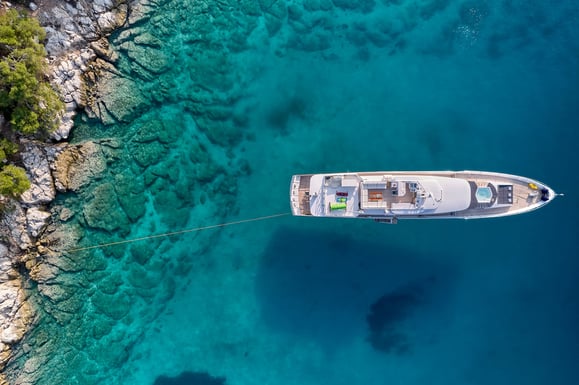
Santorini || Akrotiri, Ancient Thira and Thirassia
Also on the most famous Greek islands list, Santorini has a rich heritage and history. Its pre-historic cities were superbly advanced and there are three major archeological sites that attest to their intricacy and grandeur: the late Minoan city of Akrotiri, Ancient Thira (or Thera) and the islet of Thirassia.
In Greek mythology, Santorini was created for the love of a woman. After the Argonaut expedition, Jason’s crew stopped on Anafi, a small neighboring island. A man called Euphemus dreamt he was making love to a nymph. She got pregnant with his child and pleaded with him to hide her, so he pulled a piece of soil from Anafi and threw it into the sea. When their son was born, he was named Thiras, and he bequeathed his name to ancient Santorini, as well as its volcano.
The island was first settled around 3000 BC and became an important urban center and Aegean port. The city of Akrotiri boasted various sophistications, such as drainage systems, beautifully decorated multi-storey edifices (color frescos can be seen today), conveniences such as hot water and indoor toilets. In the 17th century BC the town and island were obliterated by earthquakes and volcanic eruptions, thus creating the famous Caldera; Akrotiri is also sometimes called “the Greek Pompei”. Within a few days, about 90 billion tons of molten rock were ejected and a massive tsunami slammed the northeastern coast of Crete. The island was abandoned for centuries after its destruction. In 1870 the French archaeologists H. Gorgeix and H. Mamet began the first excavations and in 1967 a Greek team with Professor Marinatos discovered the Late Minoan City of Akrotiri. Excavations continue to this day.
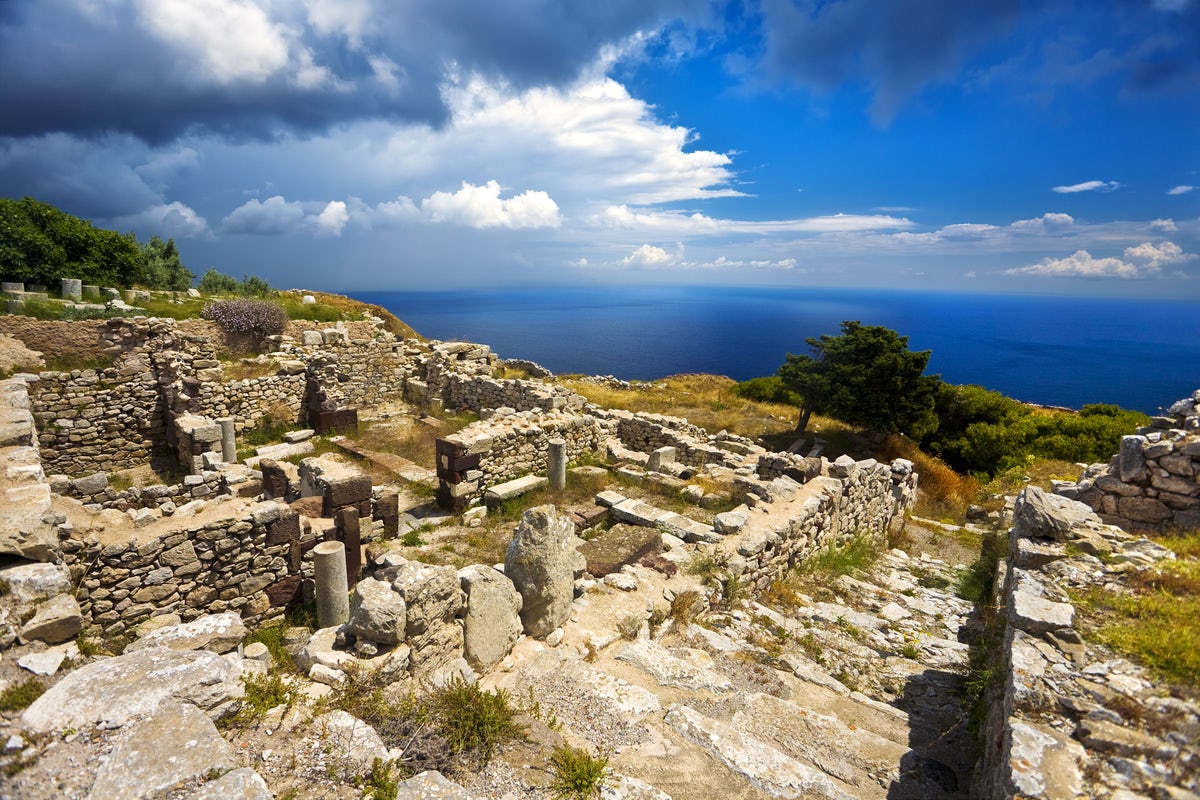
Ancient Thera - Source: link
Ancient Thira was inhabited from the 8th century BC until 726 AD. It consisted of a street almost 800 m long and especially wide for its time, containing imposing buildings made with local limestone. It was built in a strategic location, and, throughout the various stages of its occupancy, it was inhabited by Spartans, Ptolemies, as well as Egyptians. Residential areas were grouped around an Agora and there was a small sacred area with temple grounds and public facilities. Finally, on the islet of Thirassia, archeologists have discovered buildings and remnants of settlement fortifications from the Early and Middle Bronze Ages (3200 BC-1600 BC), as well as fragments of large, colorful vessels, obsidian tools, traces of weaving and spinning.
Things to know:
-
Akrotiri (at the south of the island) has been excellently preserved through the eons, as it was covered by volcanic ash. Today it’s possible to walk around the “streets” of this astonishing city. It is open for visitors from 08:30 - 15:30 (Monday, Wednesday, Thursday) and from 8:00 - 20:00 (Tuesday, Friday, Saturday, Sunday); there is also a museum on site.
-
Ancient Thira is 360m high in the Messa Vouno mountain and has Hellenistic, Roman and Byzantine ruins. Excavations started there in 1896 and the earliest art form found there was pottery from the Geometric period. You can hike or drive there from the village of Kamari. It is open to the public between 8.00 - 15.00 (closed on Mondays).
-
Thirassia is a virgin island in which about 15o people live today in small settlements. Manolas is its capital village. You can travel there with your yacht and eat in one of its local taverns; it will feel like you were visiting Santorini 40 years ago.
-
Next to Thirassia, you can also visit the island of Nea Kameni, which boasts hot springs with therapeutic warm waters.
Antiparos || Despotiko
The tiny island of Antiparos, one nautical mile from Paros, is both a calm haven and a cosmopolitan gathering point. Known by the name Oliaros in antiquity, it took its later name from one of the 50 sons of Egypt. West of Antiparos and east of the smaller island of Strongyli, one can visit the islet of Despotiko, another archeological jewel of the Cyclades.
On the islet, there is a large 6th century temple dedicated to three Olympian gods: Apollo, his sister Artemis, and Hestia; there are also other ceremonial and auxiliary buildings such as the “hestiatoreion” (banquet hall). The temple held great significance (perhaps on par with the Delos temple) and is mentioned in writings by Pliny the Elder and Strabo, who called the islet “Prepesinthos” (an alternate name is Episkopi).
Among the Despotiko finds are tombs, remains and architectural members (capitals, triglyphs, etc.) from houses and other buildings, an altar of the Classical period dedicated to Hestia Isthmia, clay figurines, alabaster, cotyles, aryballos flasks, etc. Engravings from the 15th and 17th centuries indicate the existence of a castle at the location of Mantra, and findings dating back to the Middle Ages attest to the island's habitation during this period too.
Things to know:
- The first excavations in Despotiko took place in 1890 by Christos Tsoundas, one of the most important Greek archaeologists, and continue to this day. He discovered proto-Cycladic cemeteries (Cycladic graves of 3500 BC), now exhibited in the Archaeological Museum of Athens.
-
The site remains open daily (except Tuesday) from 9:00 – 14:00. It is not organized and is under excavation and restoration. The restoration works of the temple and the sanctuary restaurant have been completed and the worship building D is being erected. Also, the access route from the jetty to the sanctuary has been completed.
-
The only island inhabitants are many, many goats.
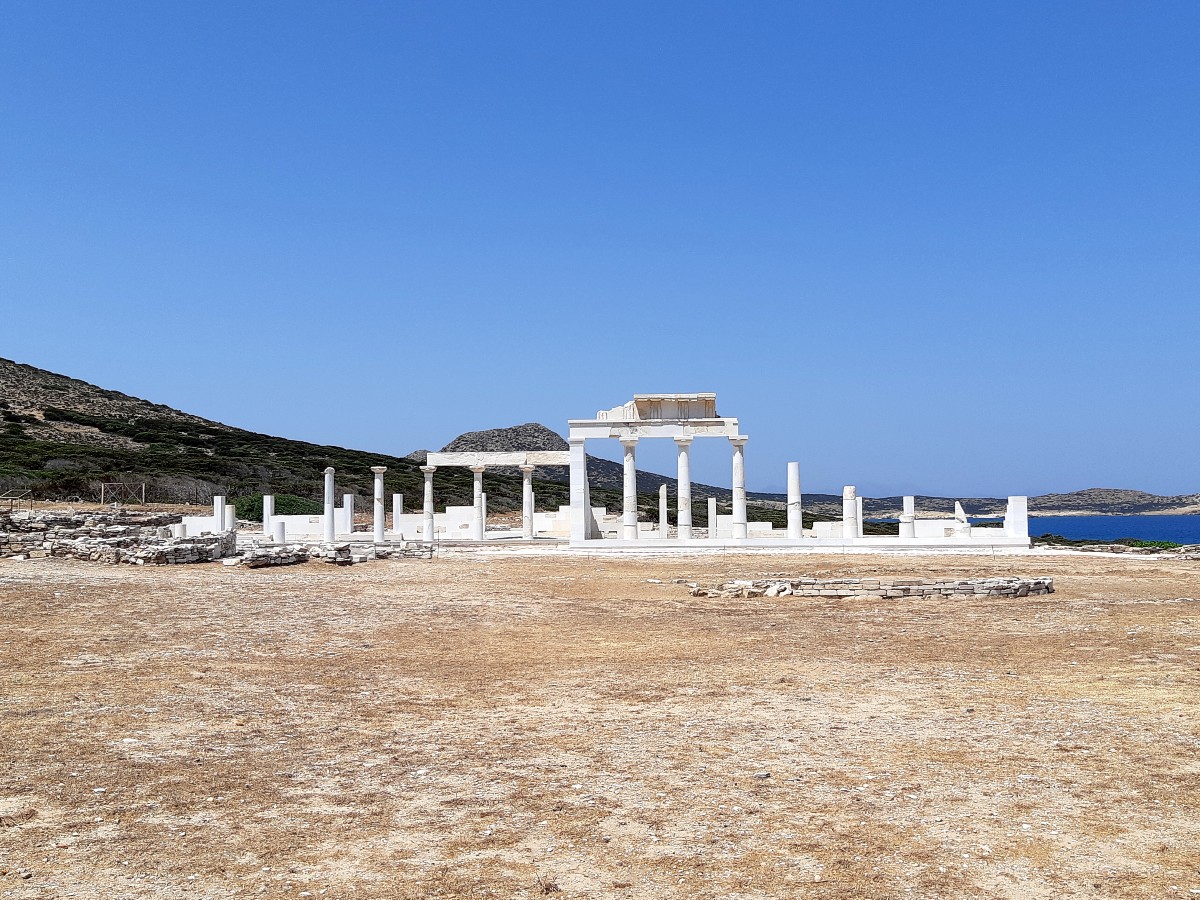
Archaelogical site at Despotiko Island - Source: link
Aegina || Temple of Aphaia
The charming Aegina, just a short trip from Athens, was, according to Greek mythology, a Naiad nymph abducted by Zeus and the mother of Aiakos, king of the island. Its most important archeological site (and one of the most remarkable in Greece) is the Temple of Aphaia. Standing on a green hill, it is part of a magnificent mystery, the theory of geodetic triangulation in the ancient Greek world. According to this (unproven) mystical and mathematical theory, the location of temples was not accidental, but created geometric formations. Various such sites form equilateral and isosceles triangles, such as the Temple of Poseidon in Sounio with the Temple of Aphaia and the Temple of Hephaestus in Thissio.
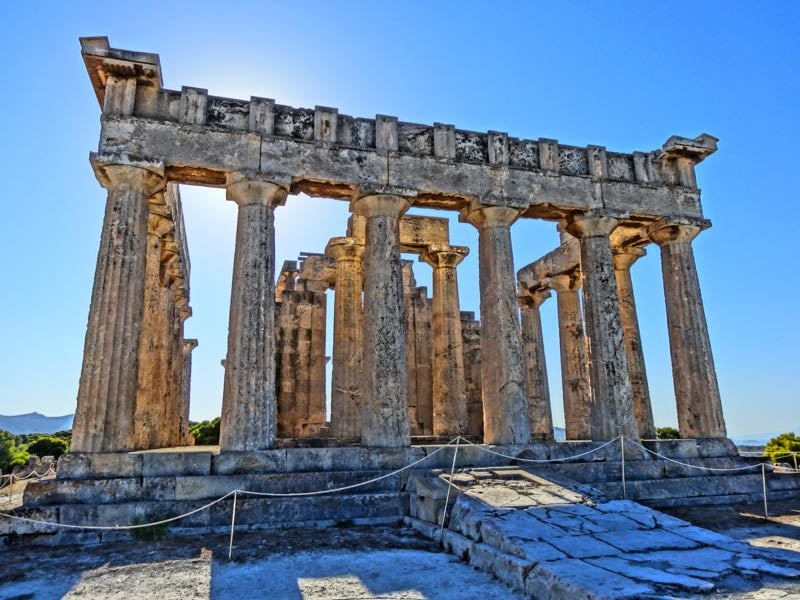
The temple of Aphaea in Aegina - Source: link
The excellently preserved temple, constructed in a Doric, peripteral hexastyle, is located within a sanctuary complex dedicated to the goddess Aphaia, a Cretan deity; it was formerly known as the Temple of Jupiter Panhellenius. The temple that we see today, constructed between 500 and 490 BC, stands on an even older sanctuary that was destroyed in a fire. Scenes and Aeginian and other heroes from Greek lore were depicted all over the temple. Pottery from various periods indicates activity on the site until the beginning of the 1st century B.C., when the sanctuary started decaying.
Things to know:
-
Systematic excavations at the site were carried out in the 20th century by the German School in Athens and even significant remains from the Bronze Age were found there. Sufficient remains were recovered to allow a complete architectural reconstruction of the structure; some remains have also been reconstructed in the on-site museum. The restoration works at the temple and the banquet hall have been completed.
-
Some of the most impressive marble pedimental sculptures from the temple were taken to Germany in 1811, were restored by Danish sculptor Bertel Thorvaldsen and reside in the Munich Glyptothek to this day.
-
The site stands on a c. 160 m peak on the northeastern side of the island and it’s 13 km from the main Aegina port if driving, but you can also go there directly via boat. The site remains open daily, apart from Wednesdays, from 10.30 - 17.30.
-
It is possible to arrange an archeological tour of the temple and museum and gain more insight on this ancient marvel.
Click here to view our charter guide.
